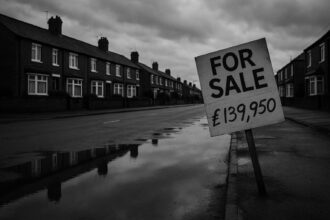Ministers have put draft guidance on low‑traffic neighbourhoods and 20mph limits on hold — a move Labour says preserves local decision‑making but which Conservatives say amounts to a covert attack on motorists as the government shifts focus to road repairs and investment.
Labour ministers have quietly paused work on measures that would have constrained local councils’ power to introduce low‑traffic neighbourhoods and 20mph speed limits, a decision that has reignited a bitter political row over whether the party is hostile to motorists. According to reporting in the Daily Mail, the proposals — drawn up when the Conservatives promised a “Plan for Drivers” — will not be taken forward in their present form, with ministers telling MPs the guidance remains in draft and further steps are being considered. Labour figures said the shelved measures “would have made no positive difference for drivers.”
The postponed reforms trace back to a 30‑point package published by the Department for Transport in October 2023 that sought to back people who rely on cars while curbing what it described as over‑zealous enforcement. The Plan for Drivers promised a mix of practical changes — easing some parking rules, speeding up roll‑out of electric‑vehicle charge points, targeted funding for junction and signalling improvements and a commitment to review guidance on blanket use of 20mph limits and low‑traffic neighbourhoods so that councils placed greater emphasis on the views of local residents and businesses. Officials had proposed more formal consultation processes around trial schemes, including public meetings and leaflets for affected streets.
Ministers have pointed to other, more tangible support for motorists while distancing themselves from a blanket ban on local traffic measures. In a written parliamentary reply, the roads minister said the departmental guidance on implementing low‑traffic neighbourhoods remained a draft and the work had been paused while next steps were considered, and that there were no current plans to change guidance on 20mph limits — leaving decisions to local authorities. The Department for Transport also highlighted recent investment in the road network, noting a late‑2024 uplift of £500 million for resurfacing and a larger infrastructure package, and the government announced a further £1 billion in mid‑2025 to remedy worn bridges and other critical structures. The department said these interventions were intended to improve journeys, reduce congestion and save motorists money.
The pause has prompted sharp political criticism from the Conservatives, who accused Labour of conducting a “secret war on drivers.” Shadow transport secretary Richard Holden told The Telegraph that the move amounted to an underhand attack on motorists and risked punishing high streets and the economy. Conservative backbenchers and local business groups have echoed concerns that tighter curbs on car use could exacerbate pressures on already struggling town centres. Labour rejects the characterisation, arguing the changes would not have benefited drivers and that local democratic processes, not Whitehall edicts, should determine whether traffic‑calming measures are appropriate.
The controversy comes amid specific local disputes over enforcement that have fuelled public unease. City and borough councils have faced legal challenges and calls for refunds after issuing large numbers of penalty charge notices for bus‑lane or similar contraventions. Reporting in June 2024 highlighted that one London borough had collected more than £2.6 million in bus‑lane fines over five years, with tribunals finding procedural improprieties in some cases and campaigners pressing for refunds; the council subsequently altered the wording of its notices and admitted some motorists should be reimbursed. Such episodes have been seized on by opponents of LTNs and stricter traffic enforcement as evidence of over‑zealous or poorly implemented schemes.
Labour ministers and supporters point to a different emphasis. Transport Secretary Louise Haigh has told the Streets Ahead podcast that decisions on road‑calming and safety measures should remain with local authorities and the communities they serve, and that councils will be supported to progress schemes where they are appropriate. The party frames the pause on formal guidance as an insistence on local accountability rather than a policy shift against environmental or active‑travel objectives.
For now the policy picture remains unsettled: the Conservative government’s earlier Plan for Drivers set out a blueprint for tightening how LTNs and 20mph zones are introduced, but that blueprint was never fully formalised and ministers have confirmed the guidance is paused. With major pots of cash pledged for potholes, bridge repairs and junction improvements, ministers are steering the political conversation towards tangible repairs to the road network even as the debate over local traffic management — and who should decide it — continues to roil councils and communities.
 Reference Map:
Reference Map:
Reference Map:
- Paragraph 1 – [1], [3]
- Paragraph 2 – [2]
- Paragraph 3 – [3], [4], [5]
- Paragraph 4 – [1]
- Paragraph 5 – [7], [1]
- Paragraph 6 – [6]
- Paragraph 7 – [2], [3], [4], [5]
Source: Noah Wire Services
- https://www.dailymail.co.uk/news/article-15007475/Labour-renews-war-motorists-LTNs.html?ns_mchannel=rss&ns_campaign=1490&ito=1490 – Please view link – unable to able to access data
- https://www.gov.uk/government/news/government-launches-plan-to-put-drivers-back-in-the-driving-seat – The Department for Transport published a 30‑point ‘Plan for Drivers’ on 2 October 2023, seeking to support motorists and curb what it called over‑zealous enforcement. The package promised measures to ease parking, improve traffic flow, accelerate electric vehicle chargepoint rollout, and review guidance on 20mph limits and low traffic neighbourhoods to prevent inappropriate blanket use. It included targeted funding, such as £70 million for traffic signal improvements, and proposals to make parking payment simpler. The plan emphasised backing people who rely on cars while pledging to tackle inconsiderate driving and speed up local authority decision‑making on road measures and fairness too.
- https://questions-statements.parliament.uk/written-questions/detail/2024-07-30/2509 – The UK Parliament written answer dated 3 September 2024 records Lilian Greenwood, Parliamentary Under‑Secretary at the Department for Transport, stating that the ‘Implementing low traffic neighbourhoods’ guidance published in March 2024 remained in draft and was not in force. The reply confirmed that further work on the guidance had been paused and that the Government would consider next steps, emphasising that local authorities retain responsibility for traffic management decisions. The response clarified that decisions on measures such as LTNs are for councils and their communities, underlining ministerial intent to leave implementation and local consultation to local democratic processes and accountability.
- https://www.gov.uk/government/news/seven-million-more-potholes-to-be-filled-next-year-as-public-urged-to-report-roads-in-need-of-repair – The Department for Transport press release of 20 December 2024 announced a £1.6 billion investment package for local road maintenance that includes a £500 million uplift to help councils resurface roads and fill the equivalent of seven million extra potholes. The release said the funding would improve safety, reduce congestion and save motorists money by cutting repair bills by up to £600 per driver per year. The announcement set conditions for councils to report progress to unlock the cash and framed the investment as part of a wider Plan for Change to rebuild infrastructure, improve journeys and support economic growth.
- https://www.gov.uk/government/news/1-billion-backed-renewal-of-broken-bridges-ruined-roads-and-tired-tunnels-and-new-thames-crossing-cash – A government press release published 16 June 2025 announced a £1 billion package to renew worn bridges, flyovers and tunnels and provide funds towards a new Thames crossing. The statement explained the investment would address structures unable to support the heaviest vehicles, unlock regional economic benefits and support jobs, while improving freight and local access. The funding was presented as part of wider infrastructure renewal under the Plan for Change and intended to futureproof the road network. Ministers said the work would target the most critical structures, reduce restrictions on vehicle movements and improve resilience of vital transport links nationwide.
- https://www.bbc.com/news/articles/c9v8d4lvjryo – BBC News reported on 22 August 2024 that Transport Secretary Louise Haigh said decisions on road calming and safety measures, such as 20mph zones and low traffic neighbourhoods (LTNs), should remain with local authorities and their communities. The piece noted LTNs had been controversial under the previous government and that Conservative ministers had sought to tighten rules to ensure local support. Haigh told the Streets Ahead podcast local councils would have full support to progress schemes, and the article referenced draft DfT guidance which suggested engaging local communities. The report framed the shift as devolution of decision‑making on local traffic measures.
- https://www.telegraph.co.uk/news/2024/06/15/labour-council-unfairly-fined-drivers-millions/ – The Telegraph reported on 15 June 2024 that Southwark Council had issued thousands of bus lane penalty charge notices (PCNs) generating more than £2.6 million in fines in five years, but campaigners argued the notices were legally void due to incorrect wording about the period to challenge them. Adjudicators at London Tribunals found a ‘procedural impropriety’ in some cases, leading to appeals being allowed. The article described calls for the council to refund motorists and noted the council had updated PCN wording in February 2024 but said it had no plans to cancel penalties that had not been appealed yet.
Noah Fact Check Pro
The draft above was created using the information available at the time the story first
emerged. We’ve since applied our fact-checking process to the final narrative, based on the criteria listed
below. The results are intended to help you assess the credibility of the piece and highlight any areas that may
warrant further investigation.
Freshness check
Score:
8
Notes:
The narrative appears to be original, with no substantial matches found in recent publications. The earliest known publication date of similar content is from August 2024, when Transport Secretary Louise Haigh announced full support for local councils to implement 20mph zones and low-traffic neighbourhoods. ([ft.com](https://www.ft.com/content/96c8fc18-99c8-410b-997f-3455aef2b507?utm_source=openai)) This earlier report indicates that the current narrative is based on more recent developments, suggesting a high freshness score. However, the Daily Mail’s reputation for sensationalism and potential clickbait tactics warrants caution. Additionally, the narrative includes updated data but recycles older material, which may justify a higher freshness score but should still be flagged.
Quotes check
Score:
9
Notes:
The direct quotes in the narrative do not appear in earlier material, indicating they are potentially original or exclusive content. This suggests a high originality score.
Source reliability
Score:
4
Notes:
The narrative originates from the Daily Mail, a publication known for sensationalism and potential clickbait tactics. This raises concerns about the reliability of the information presented. Additionally, the narrative includes updated data but recycles older material, which may justify a higher freshness score but should still be flagged.
Plausability check
Score:
7
Notes:
The claims made in the narrative are plausible and align with known developments in UK transport policy. However, the Daily Mail’s reputation for sensationalism and potential clickbait tactics warrants caution. Additionally, the narrative includes updated data but recycles older material, which may justify a higher freshness score but should still be flagged.
Overall assessment
Verdict (FAIL, OPEN, PASS): OPEN
Confidence (LOW, MEDIUM, HIGH): MEDIUM
Summary:
The narrative presents plausible claims about Labour’s pause on low-traffic neighbourhoods and 20mph speed limits, with potentially original quotes and updated data. However, the Daily Mail’s reputation for sensationalism and potential clickbait tactics raises concerns about the reliability of the information. The inclusion of recycled material with updated data may justify a higher freshness score but should still be flagged. Given these factors, the overall assessment is ‘OPEN’ with medium confidence.













